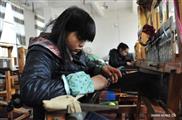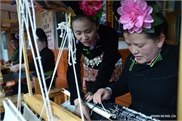ARTS / CULTURE & LEISURE
China’s ethnic Zhuang brocade weaves dreams for women at home, abroad

Villagers make hand-woven brocade at the Ximeng Impression, a local ethnic cultural company, in Yangluo Village of Wa Autonomous County of Ximeng, southwest China's Yunnan Province, Dec. 20, 2020. In recent years, the local government of Wa Autonomous County of Ximeng has been enhancing the protection of local intangible cultural heritage and helping people of Wa ethnic group preserve and inherit their ancient cultures and traditions. Cultural companies including Ximeng Impression in Yangluo Village are also participating in the efforts. They provide the locals with opportunities of learning weaving techniques and selling products of a great variety of hand-woven clothing. (Xinhua/Wang Guansen)
Sitting in front of a traditional wooden loom, 76-year-old Li Yanfen, a member of China's Zhuang ethnic minority group, started weaving brocade as usual.
Zhuang brocade, together with Yun brocade, Shu brocade and Song brocade are listed as the four famous brocades in China. In 2006, Zhuang brocade weaving skills were included in the first batch of national intangible cultural heritage lists.
Living in Longzhou county of South China's Guangxi Zhuang Autonomous Region, one of the areas where Zhuang brocade was born, Li was good at weaving and could finish a 20-cm-long brocade every day.
"Used as dowry by Zhuang people in the past, the brocade used to be a method to test if a girl was diligent and ingenious. However, traditional brocade skills were fading because the brocade then was thick, heavy, and not useful for making clothes," said Li.
The year 2016 ushered in a new stage of inheritance and development of Zhuang brocade. Guangxi Jinzhuangjin Culture and Art Co, Ltd. joined hands with Guangxi Zhuang Autonomous Region Museum and Guangxi Weaving and Embroidery Development Research Association to establish the Longzhou brocade workshop to develop cultural and creative products from Zhuang brocade.
Like Li, nearly 60 women participated in the workshop where they wove brocade for 2 to 4 hours every day with an annual salary of over 10,000 yuan ($1,546) while taking care of family members.
Li Donglian, 39, who started to learn weaving from her mother at the age of 14, is a well-known weaver in her village.
In the past, she had to work elsewhere to make a living. But in 2016, she was given an opportunity to be an ethnic brocade weaver back in her village.
To inherit and promote the craft, she organized female villagers to weave brocade and learn new skills, becoming a leader of weavers and beginning to engage in product development.
Zhuang brocade has also entered the global market. The brocade woven out of cotton yarn and silk thread in Li Yanfen's village is transported to Italy.



